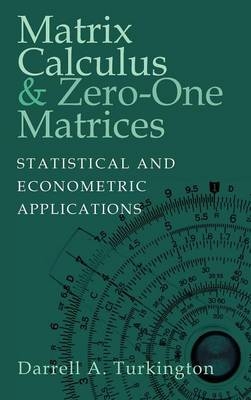
Matrix Calculus and Zero-One Matrices
Statistical and Econometric Applications
Seiten
2001
Cambridge University Press (Verlag)
978-0-521-80788-3 (ISBN)
Cambridge University Press (Verlag)
978-0-521-80788-3 (ISBN)
Shows how mathematical tools taken from matrix calculations and zero-one matrices greatly facilitate the application of classical statistical procedures to econometric models.
This 2002 book presents the reader with mathematical tools taken from matrix calculus and zero-one matrices and demonstrates how these tools greatly facilitate the application of classical statistical procedures to econometric models. The matrix calculus results are derived from a few basic rules that are generalizations of the rules of ordinary calculus. These results are summarized in a useful table. Well-known zero-one matrices, together with some newer ones, are defined, their mathematical roles explained, and their useful properties presented. The basic building blocks of classical statistics, namely the score vector, the information matrix, and the Cramer-Rao lower bound, are obtained for a sequence of linear econometric models of increasing statistical complexity. From these are obtained interactive interpretations of maximum likelihood estimators, linking them with efficient econometric estimators. Classical test statistics are also derived and compared for hypotheses of interest.
This 2002 book presents the reader with mathematical tools taken from matrix calculus and zero-one matrices and demonstrates how these tools greatly facilitate the application of classical statistical procedures to econometric models. The matrix calculus results are derived from a few basic rules that are generalizations of the rules of ordinary calculus. These results are summarized in a useful table. Well-known zero-one matrices, together with some newer ones, are defined, their mathematical roles explained, and their useful properties presented. The basic building blocks of classical statistics, namely the score vector, the information matrix, and the Cramer-Rao lower bound, are obtained for a sequence of linear econometric models of increasing statistical complexity. From these are obtained interactive interpretations of maximum likelihood estimators, linking them with efficient econometric estimators. Classical test statistics are also derived and compared for hypotheses of interest.
1. Classical statistical procedures; 2. Elements of matrix algebra; 3. Zero-one matrices; 4. Matrix calculus; 5. Linear regression models; 6. Seemingly unrelated regression equations models; 7. Linear simultaneous equations models.
| Erscheint lt. Verlag | 10.12.2001 |
|---|---|
| Zusatzinfo | 8 Tables, unspecified |
| Verlagsort | Cambridge |
| Sprache | englisch |
| Maße | 152 x 229 mm |
| Gewicht | 500 g |
| Themenwelt | Mathematik / Informatik ► Mathematik ► Algebra |
| Wirtschaft ► Volkswirtschaftslehre ► Ökonometrie | |
| ISBN-10 | 0-521-80788-3 / 0521807883 |
| ISBN-13 | 978-0-521-80788-3 / 9780521807883 |
| Zustand | Neuware |
| Haben Sie eine Frage zum Produkt? |
Mehr entdecken
aus dem Bereich
aus dem Bereich
Buch | Softcover (2022)
Springer Spektrum (Verlag)
39,99 €


